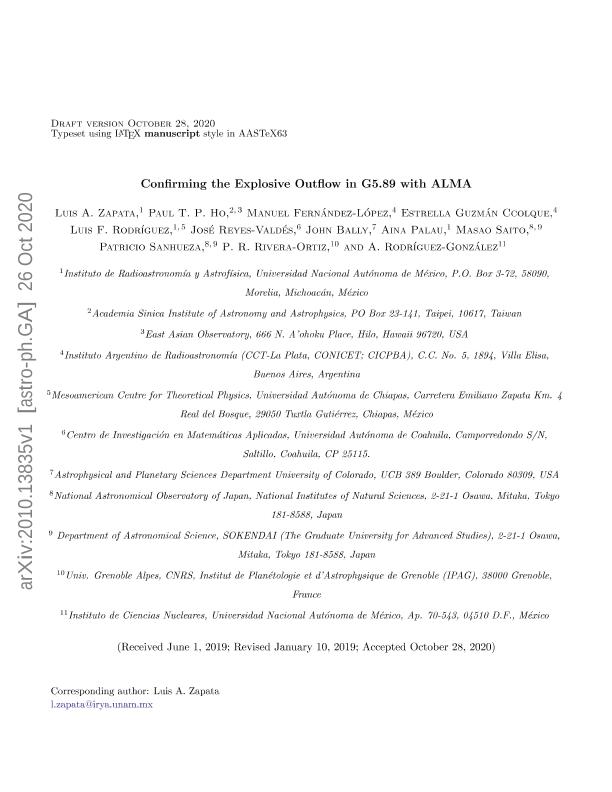Mostrar el registro sencillo del ítem
dc.contributor.author
Zapata, Luis A.
dc.contributor.author
Ho, Paul T. P.
dc.contributor.author
Fernandez Lopez, Manuel

dc.contributor.author
Guzmán Ccolque, Estrella

dc.contributor.author
Rodríguez, Luis F.
dc.contributor.author
Reyes Valdés, José
dc.contributor.author
Bally, John
dc.contributor.author
Palau, Aina
dc.contributor.author
Saito, Masao
dc.contributor.author
Sanhueza, Patricio
dc.contributor.author
Rivera Ortiz, P. R.
dc.contributor.author
Rodríguez González, A.
dc.date.available
2020-12-30T15:40:59Z
dc.date.issued
2020-10
dc.identifier.citation
Zapata, Luis A.; Ho, Paul T. P.; Fernandez Lopez, Manuel; Guzmán Ccolque, Estrella; Rodríguez, Luis F.; et al.; Confirming the Explosive Outflow in G5.89 with ALMA; IOP Publishing; Astrophysical Journal Letters; 902; 2; 10-2020
dc.identifier.issn
2041-8205
dc.identifier.uri
http://hdl.handle.net/11336/121362
dc.description.abstract
The explosive molecular outflow detected decades ago in the Orion BN/KL region of massive star formation was considered to be a bizarre event. This belief was strengthened by the nondetection of similar cases over the years with the only exception of the marginal case of DR21. Here, we confirm a similar explosive outflow associated with the UCHII region G5.89-0.39 that indicates that this phenomenon is not unique to Orion or DR21. Sensitive and high angular resolution (∼0.″1) Atacama Large Millimeter/submillimeter Array (ALMA) CO(2-1) and SiO(5-4) observations show that the molecular outflow in the massive star-forming region G5.89-0.39 is indeed an explosive outflow with an age of about 1000 yr and a liberated kinetic energy of 1046-49 erg. Our new CO(2-1) ALMA observations revealed over 30 molecular filaments, with Hubble-like expansion motions, pointing to the center of UCHII region. In addition, the SiO(5-4) observations reveal warmer and strong shocks very close to the origin of the explosion, confirming the true nature of the flow. A simple estimation for the occurrence of these explosive events during the formation of the massive stars indicates an event rate of once every ∼100 yr, which is close to the supernovae rate.
dc.format
application/pdf
dc.language.iso
eng
dc.publisher
IOP Publishing

dc.rights
info:eu-repo/semantics/openAccess
dc.rights.uri
https://creativecommons.org/licenses/by-nc-sa/2.5/ar/
dc.subject
Star formation
dc.subject
Massive stars
dc.subject
Stellar jets
dc.subject
Stellar Interactions
dc.subject
Interstellar Interactions
dc.subject.classification
Astronomía

dc.subject.classification
Ciencias Físicas

dc.subject.classification
CIENCIAS NATURALES Y EXACTAS

dc.title
Confirming the Explosive Outflow in G5.89 with ALMA
dc.type
info:eu-repo/semantics/article
dc.type
info:ar-repo/semantics/artículo
dc.type
info:eu-repo/semantics/publishedVersion
dc.date.updated
2020-12-04T18:35:31Z
dc.identifier.eissn
2041-8213
dc.journal.volume
902
dc.journal.number
2
dc.journal.pais
Estados Unidos

dc.description.fil
Fil: Zapata, Luis A.. Instituto de Radioastronomía y Astrofísica; México
dc.description.fil
Fil: Ho, Paul T. P.. Academia Sinica; China
dc.description.fil
Fil: Fernandez Lopez, Manuel. Provincia de Buenos Aires. Gobernación. Comisión de Investigaciones Científicas. Instituto Argentino de Radioastronomía. Consejo Nacional de Investigaciones Científicas y Técnicas. Centro Científico Tecnológico Conicet - La Plata. Instituto Argentino de Radioastronomía; Argentina
dc.description.fil
Fil: Guzmán Ccolque, Estrella. Provincia de Buenos Aires. Gobernación. Comisión de Investigaciones Científicas. Instituto Argentino de Radioastronomía. Consejo Nacional de Investigaciones Científicas y Técnicas. Centro Científico Tecnológico Conicet - La Plata. Instituto Argentino de Radioastronomía; Argentina
dc.description.fil
Fil: Rodríguez, Luis F.. Universidad Autónoma de Chiapas; México. Instituto de Radioastronomía y Astrofísica; México
dc.description.fil
Fil: Reyes Valdés, José. Universidad Autonoma de Coahuila; México
dc.description.fil
Fil: Bally, John. State University of Colorado at Boulder; Estados Unidos
dc.description.fil
Fil: Palau, Aina. Instituto de Radioastronomía y Astrofísica; México
dc.description.fil
Fil: Saito, Masao. National Institutes Of Natural Sciences - National Astronomical Observatory Of Japan; Japón
dc.description.fil
Fil: Sanhueza, Patricio. National Institutes Of Natural Sciences - National Astronomical Observatory Of Japan; Japón
dc.description.fil
Fil: Rivera Ortiz, P. R.. Universite Grenoble Alpes; Francia
dc.description.fil
Fil: Rodríguez González, A.. Universidad Nacional Autónoma de México; México
dc.journal.title
Astrophysical Journal Letters
dc.relation.alternativeid
info:eu-repo/semantics/altIdentifier/doi/http://dx.doi.org/10.3847/2041-8213/abbd3f
dc.relation.alternativeid
info:eu-repo/semantics/altIdentifier/url/https://iopscience.iop.org/article/10.3847/2041-8213/abbd3f
Archivos asociados
